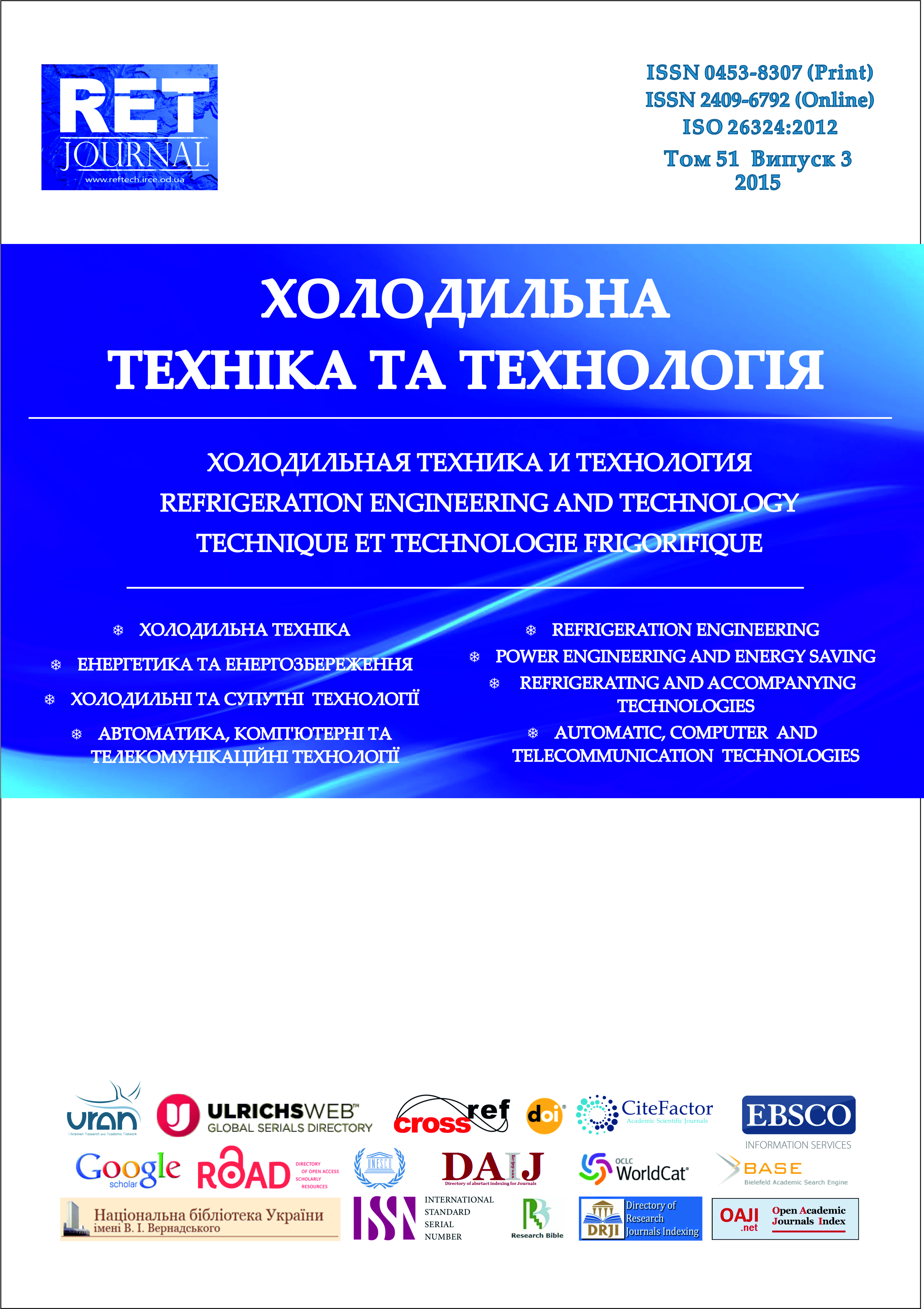EXPERIMENTAL STUDIES OF CAPABILITIES FOR ENHANCEMENT OF VAPORIZATION HEAT TRANSFER AT THE MICROCHANNEL SURFACES
DOI:
https://doi.org/10.15673/0453-8307.3/2015.40897Keywords:
micro-grooved structure – vaporization – heat transfer – critical heat flux.Abstract
The use of grooves, as the structure of flat plate heat pipe is widespread and is a popular and effective technical solution in the practical implementation of various design systems for thermal control of electronic equipment. Advanced thermal control system must meet two criteria: 1) have a high heat transfer coefficient; 2) remove heat of high density. However, the last criterion leads to the fact that the high density heat flux may lead to a boiling limit, which leads to a drastic decrease in heat transfer coefficient, and conducts to a rapid increase of surface temperature. The paper presents an experimental investigation of the heat transfer characteristics of the microgrooved structures at vaporization of water and ethanol. The structures are represented in the form of axial grooves with a square section dimensions of 0.3, 0.5 and 0.7 mm, and a rectangular cross section with the same width and pitch parameters of the channel but with double depth of channels. Studies showed that in the grooved structures three modes of vaporization occur as follows: evaporation, evaporation-pulsation and boiling. The experiment revealed the area having constancy of the heat transfer coefficient at varying specific heat flux that is typical for evaporation. At certain heat flux value the nucleate boiling in the grooves is initiated, and heat transfer coefficient is growing at increasing heat flux. Boiling in the channels of micro-grooved surface is accompanied by a slug boiling regime, and formation of a thin liquid film on the surface of the channel. It is essentially increasing the heat transfer characteristics of the micro-grooved structures. Double of the channel depth leads to increase in heat transfer coefficient up to 30 - 40% for both water and ethanol. Increase of the heat transfer coefficient could be explained by the enlargement of the heat transfer surface of the channels. Increasing of the effective pore radius by the increasing of the channels depth leads to reduction in the hydraulic resistance of the channels that accompanies increase of the critical heat flux up to 50 - 60%.
References
Kim, S.J., Seo, J.K., Do, K.H. 2003. Analytical and experimental investigation on the operational characteristics and the thermal optimization of a min-iature heat pipe with a grooved wick structure. Int. J. Heat Mass Transfer, 46(11), 2051-2063. doi: 10.1016/s0017-9310(02)00504-5
Lefèvre, F., Conrardy, J.B., Martin Raynaud, Jocelyn Bonjour. 2012. Experimental investigations of flat plate heat pipes with screen meshes or grooves covered with screen meshes as capillary structure. Appl. Therm. Eng., 37, 95-102. doi: 10.1016/j.applthermaleng.2011.11.022
Kondratenko, A.A., Burdo, O.H., Kosoy, B.V., Slobodenyuk, M.Y. 2013. Experimental studies of vaporization process on microcapillary structures of flat plate heat pipes. Industrial Heat Engineering, 35(7), 82-87. (in Russian).
Chen Li, G.P. Peterson, 2006. Evapora-tion/boiling in thin capillary wicks (I) e Wick thickness effect. J. Heat Transfer, 128(12), 1312–1319. doi: 10.1115/1.2349507
. Chen Li, G.P. Peterson, 2006. Evapora-tion/boiling in thin capillary wicks (II) e Effects of volumetric porosity and mesh size. J. Heat Transfer, 128(12), 1320-1328. doi: 10.1115/1.2349508
S.-W. Chen et al., 2007. Experimental investiga-tion and visualization on capillary and boiling limits of micro-grooves made by different processes. Sens. Actuat. A: Phys., 139(1-2), 78–87. doi: 10.1016/j.sna.2007.03.009
Aghvami, M., Faghri, A. 2011. Analysis of flat heat pipes with various heating and cooling configura-tions // Appl. Therm. Eng.– Vol. 31(14-15). – Р. 2645–2655. doi: 10.1016/j.applthermaleng.2011.04.034
Harmand, S., Sonan, R., Fakès, M., Hassan, H. 2011. Transient cooling of electronic components by flat heat pipes. Appl. Therm. Eng., Vol. 31(11-12), 1877–1885. doi: 10.1016/j.applthermaleng.2011.02.034
Lefevre, F., Rullière, R., Lips, S., Bonjour, J. 2010. Confocal microscopy applied to capillary film measurements in a radial flat plate heat pipe made of silicon. J. Heat Transfer, 132(3), 031502. doi: 10.1115/1.4000057
Lips, S., Lefèvre, F., Bonjour, J. 2010. Combined effects of the filling ratio and the vapor space thickness on the performance of a flat plate heat pipe. Int. J. Heat Mass Transfer, 53(4), 694–702. doi: 10.1016/j.ijheatmasstransfer.2009.10.022


